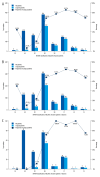Ten-Year Trends in Pelvic Fractures Among China's Aging Population: A Retrospective Single-Center Study
- PMID: 40481625
- PMCID: PMC12153403
- DOI: 10.12659/MSM.948835
Ten-Year Trends in Pelvic Fractures Among China's Aging Population: A Retrospective Single-Center Study
Abstract
BACKGROUND Pelvic fractures are a growing concern, particularly among the elderly, but data on fracture patterns in mainland China are limited. This study investigated the epidemiological trends of pelvic fractures amid an aging population in China. MATERIAL AND METHODS This retrospective study enrolled consecutive pelvic fracture patients aged ≥14 years treated at a level-1 trauma center in Beijing, China, between January 2013 and December 2022. Clinical and radiological data were collected and fractures were classified using Young-Burgess and AO/OTA systems based on X-ray and CT scans. Epidemiological trends were analyzed over the decade. RESULTS A total of 1037 eligible patients were enrolled in this study. We observed an increase in case numbers and mean age of pelvic fracture patients, along with marked growth in both the number and proportion of elderly patients (≥60 years). Males were more prevalent overall, but females outnumbered males in patients over 70 years. Elderly patients had fewer urethral, spinal, and abdominal injuries but more comorbidities compared to younger patients. Fracture classification distribution remained stable over time (P>0.05) but differed significantly between younger and elderly patients (P<0.05). Surgical intervention rates increased significantly in the latter 5 years (P<0.05), with higher rates in younger patients (P<0.05). CONCLUSIONS The study reveals notable epidemiological shifts in pelvic fractures in China from 2013 to 2022, with a rise in elderly patients and variations in fracture patterns and treatments across age groups, highlighting the effects of an aging population.
Conflict of interest statement
Figures







References
-
- Melhem E, Riouallon G, Habboubi K, et al. Epidemiology of pelvic and acetabular fractures in France. Orthop Traumatol Surg Res. 2020;106(5):831–39. - PubMed
-
- Lundin N, Huttunen TT, Berg HE, et al. Increasing incidence of pelvic and acetabular fractures. A nationwide study of 87,308 fractures over a 16-year period in Sweden. Injury. 2021;52(6):1410–17. - PubMed
-
- Herteleer M, Dejaeger M, Nijs S, et al. Epidemiology and secular trends of pelvic fractures in Belgium: A retrospective, population-based, nationwide observational study. Bone. 2021;153:116141. - PubMed
-
- Kannus P, Palvanen M, Niemi S, et al. Epidemiology of osteoporotic pelvic fractures in elderly people in Finland: Sharp increase in 1970–1997 and alarming projections for the new millennium. Osteoporos Int. 2000;11(5):443–48. - PubMed
MeSH terms
LinkOut - more resources
Full Text Sources
Medical

